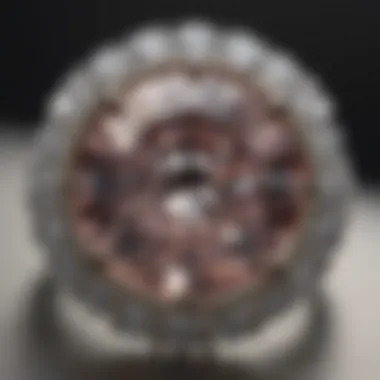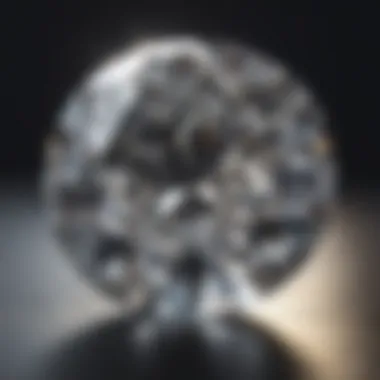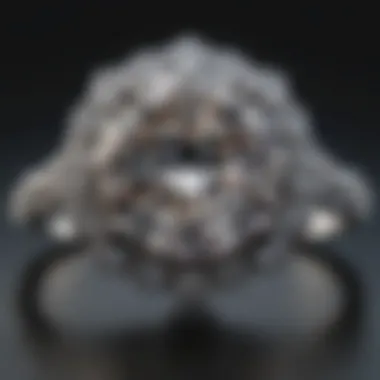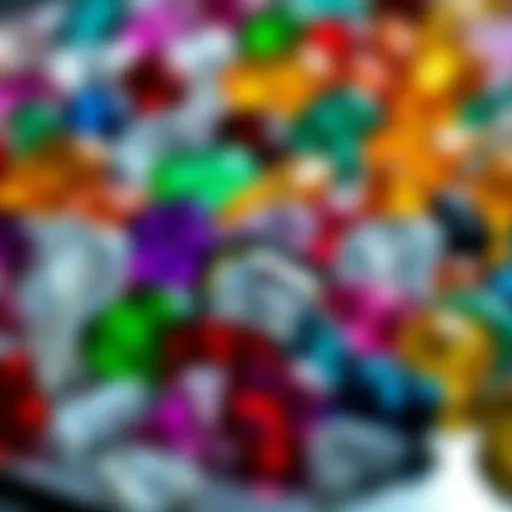Exploring the Allure of 2.5 Round Diamond Rings


Intro
2.5 round diamond rings possess a unique appeal. They merge beauty with symbolism, making them a favored choice for many buyers. This section begins the exploration of their allure by examining their intrinsic qualities and the stories they may hold.
Gemstone Overview
Definition and characteristics
Round diamonds are cut with precision to enhance their brilliance and fire. A 2.5 round diamond refers to the weight, approximately equivalent to 2.5 carats. This size is striking, making it an ideal choice for engagement rings. The shape allows for optimal reflection and refraction of light, resulting in a captivating sparkle.
These diamonds exhibit symmetry, which is significant in assessing quality. Aspects like the table diameter, crown angle, and pavilion depth can affect how light interacts with the stone. A well-cut round diamond will reflect light beautifully, enhancing its visual appeal.
Classification of gemstones
Gemstones are categorized based on their physical and chemical properties. Diamonds, specifically, classify as precious stones. They are often compared with sapphires, rubies, and emeralds, which are valued similarly but may not showcase the same levels of brilliance.
Diamonds derive their classification not only from their beauty but also from their hardness and durability. Thus, they are suitable for daily wear, particularly in rings. Understanding the classification aids in contextualizing the value and significance of round diamonds within the broader gemstone category.
Properties of Gemstones
Physical properties
The primary physical property of a diamond is its hardness. It ranks highest on the Mohs scale at ten. This hardness ensures that a diamond ring maintains its luster over time, resisting scratches and damage. A round diamond's optical properties play a critical role in its desirability.
Its brilliance is further influenced by factors like clarity. Inclusions can affect the visual appeal but a flawless diamond carries a higher price tag. Other characteristic traits include color, with rare colors such as blue or pink fetching elevated values.
Chemical properties
Diamonds are composed of carbon atoms arranged in a crystal lattice structure. This unique makeup not only provides exceptional hardness but also plays a role in how diamonds interact with light. The purity of a diamond can greatly impact its overall appearance and value.
Understanding these chemical properties allows collectors and enthusiasts to appreciate what makes a 2.5 round diamond ring more than just a piece of jewelry; it represents a convergence of nature's artistry and geological processes.
"A diamond's value is a reflection of its unique combination of attributes, transcending mere adornment to embody personal significance and heritage."
Exploring the allure of these exquisite rings demands a thorough examination of their properties, ensuring potential buyers make informed choices. Continuing this journey will reveal the cultural implications and market trends associated with 2.5 round diamonds.
Preamble to 2. Round Diamond Rings
The significance of 2.5 round diamond rings extends well beyond their aesthetic appeal, delving into areas of personal expression, tradition, and investment. They represent a blend of timeless beauty and modern desires. This article aims to unravel the various aspects that contribute to the allure of these striking gem pieces.
Understanding 2.5 round diamonds involves acknowledging their specific features. These diamonds, with their precise carat weight, often strike a balance between size and quality. This weight is popular for many buyers, making them a sought-after choice for engagement rings and other jewelry pieces. The focus here will be on defining what makes round diamonds different and highlighting their significance in contemporary culture.
From understanding their history to recognizing their technical attributes, this section sets a foundation for the detailed exploration ahead. Key considerations include their historical value, cultural implications, and the evolving market trends surrounding them.
As we proceed, this exploration aims to provide valuable insights for gemstone enthusiasts, collectors, and jewelry designers alike. The intention is not just to celebrate their beauty but to understand their multifaceted nature and what they might signify for an individual's personal journey.


Characteristics of 2. Round Diamonds
Understanding the characteristics of 2.5 round diamonds is crucial for anyone considering purchasing such a significant piece of jewelry. These diamonds are not only beautiful but also carry intrinsic value that is influenced by various factors. The characteristics of cut, clarity, color, and carat weight come together to form the foundation of a diamond's quality and desirability. Each element plays a role in not only how the diamond looks but also how it is perceived in the market.
Cut Quality
Importance of Cut
The cut of a diamond is arguably the most vital aspect influencing its overall appearance. This characteristic affects how light interacts with the diamond, impacting its brilliance and sparkle. A well-cut diamond can appear larger and more luminous than its actual size, enhancing its allure. In this article, the emphasis on cut serves to inform readers about why a precise cut leads to a more captivating gem. A poorly cut diamond, even if it has a high carat weight, will not exhibit the same brilliance. Thus, understanding the importance of cut is critical for those looking to invest in a 2.5 round diamond.
Factors Affecting Cut Quality
Several factors affect cut quality, including the angles and proportions of the diamond. The proportions must be balanced for optimal light reflection. If a diamond is cut too shallowly or too deeply, this can cause light to escape rather than refract back to the observer. By examining these factors, potential buyers can appreciate how they influence visual appeal and resale value. Cut quality is not just a matter of aesthetics; it directly correlates with the diamond's brilliance and, consequently, its value.
Clarity Grading
Understanding Clarity
Clarity refers to the presence of internal or external flaws in a diamond. These imperfections can affect how light travels through the gem, impacting its overall sparkle. Clarity grading ranges from flawless to included, with each grade having a direct influence on the diamond's market value. Understanding clarity equips potential buyers with the knowledge to make informed decisions, ensuring they select a gem that meets their aesthetic standards and budget.
Implications of Clarity on Value
The clarity of a diamond plays a significant role in determining its worth. A higher clarity grade typically commands a higher price due to its rarity. For example, diamonds with fewer inclusions are more sought after in the market. This understanding allows buyers to weigh the trade-offs between clarity and price, making it easier to choose a 2.5 round diamond that fits both their preferences and budget constraints.
Color Considerations
Color Grading Scale
Diamonds come in a variety of colors, with a grading scale that ranges from colorless to light yellow or brown. The grading system assigns letters from D to Z to indicate the degree of color, with D being completely colorless. A colorless diamond allows maximum light return, enhancing its brilliance. Understanding this scale is important for buyers who want a 2.5 round diamond that will maintain its visual appeal over time and remain a valuable asset.
Cultural Perceptions of Color
Color also carries cultural meanings, influencing buyer preferences. For instance, colorless diamonds may symbolize purity and love, while some cultures celebrate yellow diamonds for their rarity and warmth. Knowing these cultural perceptions can provide deeper insights into the significance of the chosen diamond, allowing buyers to select a gem that resonates with their values or the sentiments of the occasion.
Carat Weight Factors
Understanding Carat Weight
Carat weight is a measure of a diamond's size and weight. One carat equals 200 milligrams. This aspect affects the price directly; larger diamonds typically cost significantly more per carat. Understanding carat weight is essential for buyers aiming to balance size with their budget. A 2.5 carat diamond represents a sizeable yet manageable choice, appealing to those who desire a prominent piece without breaking the bank.
Optimal Carat Weight for 2. Round Diamonds
The optimal carat weight for a ring will depend on personal preference and style. A 2.5 round diamond strikes an appealing aesthetic balance, providing enough presence on the hand without overwhelming it. This carat weight is often seen as a perfect middle ground, allowing buyers to enjoy a striking visual statement while remaining within a reasonable price range.
The Buying Experience


When considering a 2.5 round diamond ring, the buying experience plays a crucial role in obtaining a piece of jewelry that not only meets aesthetic preferences but also embodies quality and value. This journey encompasses several essential elements that influence the satisfaction of the buyer and the overall worth of the diamond. A thoughtful approach can lead to informed decisions, ultimately enhancing the enjoyment of your investment.
Selecting a Trusted Jeweler
Choosing a reputable jeweler is paramount in the buying process. A trusted jeweler offers expertise and integrity, which are critical when dealing with valuable gemstones. They should have a clear track record of positive customer experiences, which can typically be found through reviews and ratings. Engaging with a jeweler who is willing to educate their clients is equally important. This education includes insights into diamond qualities and market trends, helping buyers make informed decisions. Additionally, a good jeweler will provide transparency in pricing and certification details, ensuring a fair purchase.
Certification Importance
The presence of certification is a vital aspect of purchasing a diamond. Certification serves as a validation of the diamond's quality and standards. It assures buyers that they are getting what they are paying for, which is especially important for high-value items like a 2.5 round diamond ring.
Reputable Certifications
The significance of reputable certifications cannot be overstated. Certifications from organizations like the Gemological Institute of America (GIA) and the International Gemological Institute (IGI) provide credible assessments of diamond quality. These reports describe cut, clarity, color, and carat weight, serving as trustworthy references for pricing and desirability. A notable characteristic of these certifications is their objective grading system, which buyers can rely on for making comparisons. The advantage here is clarity and assurance, but it is also crucial to understand that not all certifications hold the same weight. Researching the certifying body can guide buyers to make the most relevant choice.
Understanding Certification Reports
Understanding certification reports is equally essential for potential buyers. These reports detail the specifics of the diamond's grade and characteristics presented in a format that can be comprehended easily. A key aspect of these reports is their straightforward language, which helps demystify technical information. The unique feature lies in the grading scale used to assess diamond quality. Knowing how to read these reports allows buyers to recognize value and make comparisons across selections effectively. However, the downside can include terminology that may be confusing for novice buyers without adequate background knowledge, emphasizing the need for guidance when interpreting details.
Budgeting for a 2. Round Diamond Ring
Budgeting is an essential consideration in the buying process. Establishing a clear budget before exploring options can prevent impulsive decisions and facilitate more strategic choices. When budgeting, buyers should take into account various factors such as the diamond's characteristics, certification costs, and potential markups from jewelers. It is also wise to set aside a portion of the budget for future maintenance and cleaning costs, ensuring the diamond remains in optimal condition.
Negotiating the Purchase
Negotiation is an art form that can contribute significantly to the buying experience. Engaging in open conversations with the jeweler regarding price and value perceptions can lead to favorable outcomes. Buyers should feel confident to inquire about discounts or consider bundling services like cleaning or insurance to sweeten the deal. However, it is important to approach negotiations respectfully and with a solid understanding of market values. Confidently knowing the worth of the diamond based on its certification will strengthen a buyer’s position during this process.
Care and Maintenance of 2. Round Diamonds
The care and maintenance of 2.5 round diamonds are crucial to preserving their beauty and value. Proper attention to these aspects can enhance the longevity of the ring while maintaining its sparkle and clarity. Ignoring maintenance can lead to tarnishing, scratching, or dullness over time, which diminishes the gemstone's allure. It is essential for owners to adopt effective cleaning methods and storage recommendations to protect their investment and ensure their diamond remains a cherished possession.
Cleaning Methods
Regular cleaning is vital for maintaining the brilliance of a 2.5 round diamond. Dust, oils, and other residues can accumulate on the surface, obstructing light and dulling the diamond's appearance. Here are some effective cleaning methods:
- Soap and Water Solution: Mix a few drops of mild dish soap in lukewarm water. Soak the ring for about 20 to 30 minutes. Use a soft toothbrush to gently scrub the diamond and the setting. Rinse well with clean water and dry with a lint-free cloth.
- Ultrasonic Cleaners: These devices use high-frequency sound waves to agitate a cleaning solution, effectively removing dirt and grime. When using an ultrasonic cleaner, ensure that the diamond is secure in its setting to prevent loosening or damage.
- Professional Cleaning: It is advisable to have the diamond ring professionally cleaned at least once a year. Jewelers can offer deeper cleaning techniques and will examine the setting for any wear or damage.
"Regular cleaning can prevent accumulated dirt that hides the true beauty of the diamond."
Storage Recommendations
Storing a 2.5 round diamond ring properly is just as important as cleaning it. Proper storage can minimize the risk of scratches or damage. Here are some best practices:
- Use a Soft Pouch: When not wearing the ring, store it in a soft cloth pouch or a separate compartment in a jewelry box. This prevents contact with other jewelry that could scratch the diamond.
- Avoid Humid Environments: Store diamonds in cool, dry places. Humidity can cause moisture buildup, leading to tarnishing of the setting.
- Keep Away from Chemicals: Exposure to harsh chemicals, such as bleach or chlorine, can harm both the diamond and the metal setting. It's crucial to remove the ring when doing household chores or swimming in chlorinated water.
By following these methods for cleaning and storage, owners can maintain the allure and integrity of their 2.5 round diamonds over the years.


Cultural and Symbolic Significance
The cultural and symbolic significance of 2.5 round diamond rings transcends mere aesthetic appreciation. These diamonds serve as vessels of emotion and history, often embodying personal stories that shape individual identities. In various cultures, diamonds are seen as symbols of fidelity, love, and achievement. Thus, the choice of a 2.5 round diamond can represent much more than a simple engagement ring; it signifies a deep commitment and an emotional bond.
The Role of Diamonds in Engagement
Engagement rings, particularly those featuring a 2.5 round diamond, play an integral role in romantic traditions worldwide. The round diamond effectively catches light and reflects brilliance, symbolizing clarity and everlasting love. In many societies, this specific carat weight represents a balance between opulence and practicality.
A trend emerges in the choiciness of materials used for mounting these diamonds. Common settings include yellow gold, white gold, and platinum, each carrying its unique connotations. For example, yellow gold may evoke warmth and tradition, while platinum signifies durability and high status. Couples often contemplate these choices to align with their values and style. In some cultures, the act of presenting a diamond ring holds traditional roots, emphasizing its permanence in shared life journeys.
Symbolism of Round Diamonds
Round diamonds are often regarded as the quintessence of elegance. They signify perfection and completeness, characteristics that are highly valued in various cultural contexts. The round shape has deep-seated connections to notions of eternity, with no beginning or end, echoing the infinite nature of love and commitment between partners.
"The round diamond is not just a stone; it is a reminder of promises made and futures envisioned."
Moreover, round diamonds are traditionally seen as more versatile, capable of complementing various styles and designs. This adaptability makes them favored choices across cultures, from western engagement traditions to eastern celebrations. Their clarity in cut and brilliance in shine contribute to the allure that captivates admirers worldwide, inspiring jewelry designers and collectors alike.
Market Trends for 2. Round Diamonds
The diamond market has seen fluctuations that have affected pricing, availability, and demand for specific types of stones. Understanding these market trends for 2.5 round diamonds is vital for buyers, sellers, and collectors alike. These trends provide insights that help make informed decisions regarding purchases, investments, or designs involving these captivating gems.
Current Pricing Trends
The pricing of 2.5 round diamonds is influenced by various factors. Among these factors are market demand, economic conditions, and specific qualities of each diamond, such as cut, clarity, color, and carat weight.
- Economic Factors: Fluctuations in the economy can affect consumer spending habits. When the economy is strong, demand for luxury items like diamond rings increases, leading to higher prices.
- Market Demand: The popularity of round diamonds has remained strong over the years. As couples continue to favor these stones for engagements, sellers may adjust prices based on this reliable demand.
- Technological Advances: With better technology in diamond mining and cutting, there are more high-quality stones available. This often leads to competitive pricing. However, unique and rare stones may see an increase in value.
- Supply Chain Dynamics: Global events or changes in regulation can affect the supply chain for diamonds. Any disruption can lead to tighter supplies, which may push prices up.
In recent years, the average price of 2.5 round diamonds has shown a consistent upward trajectory, making it important for potential buyers to stay informed about pricing trends.
Investment Potential
Investing in 2.5 round diamonds can be appealing, but it is crucial to view this through a lens of research and understanding.
- Historical Value: Historically, diamonds have been seen as a stable investment. Those seeking to purchase 2.5 round diamonds should consider past performance, as these gems tend to maintain or increase their value over time.
- Collector Interest: As more enthusiasts enter the market, the demand for unique and high-quality round diamonds rises. This growing interest offers investment potential beyond the aesthetic appeal of the stones.
- Market Resilience: While diamond prices can be susceptible to fluctuations, typically, they display a level of resilience during economic downturns, particularly for higher-quality stones like 2.5 round diamonds.
- Diversification Opportunity: For those with significant investments in other markets, adding diamonds to an investment portfolio can provide diversity and act as a hedge against inflation.
Investors should note that market dynamics can vary yearly. Therefore, doing due diligence and consulting with gemstone experts before making significant investments is crucial.
The End
The discussion surrounding 2.5 round diamond rings culminates in a realization of their multifaceted importance in both personal and cultural contexts. This article highlights key elements such as the intrinsic value of these diamonds, their aesthetic appeal, and the various factors that influence purchasing decisions. Understanding these dimensions is crucial for anyone considering such an investment.
Summary of Key Points
In summary, the exploration of 2.5 round diamond rings reveals several critical insights:
- Characteristics: The cut, clarity, color, and carat weight all play fundamental roles in determining the quality and desirability of a diamond.
- Buying Experience: Selecting a reputable jeweler and verifying certification are pivotal steps. Price negotiation can greatly affect the overall cost of a purchase.
- Maintenance: Proper cleaning and storage ensure the longevity of the diamond’s appearance and integrity.
- Cultural Significance: The diamond remains a powerful symbol of love and commitment, particularly in the context of engagements.
- Market Trends: Buyers should be aware of the current pricing trends and potential investment value of 2.5 round diamonds.
Final Thoughts on 2. Round Diamonds
The investment in a diamond, especially one as significant as a 2.5 round diamond, is both a commitment to quality and a testament to love.



